Social proof in marketing – how susceptible are you to the behaviours of others?
As consumers, we’re walking contradictions.
You buy things that you don’t need, want and quite often, never use. In most cases, your decision to buy is based on a simple psychological trigger – just ask Apple, Netflix or Amazon.
This sounds great for marketers, but the problems begin when we implement these triggers.
Psychological buying triggers, like people, are temperamental. As we explore the use of social proof in marketing, you’ll come to understand that the ‘right’ triggers can have damaging (read: fatal) implications for your marketing campaigns when used in the wrong way. And equally, the ‘wrong’ triggers can have rewarding (read: life-changing) effects when used correctly.
In this article, we won’t just explore the topic from the outside, I’ll be putting social proof to the test on video – with an eye-opening Facebook ad test and an interesting (and entertaining) leaflet test on the highstreet.
What is Social Proof in Marketing?
Social proof in marketing describes the psychological effect of seeing others undertake an action before us. In theory, we’re much more likely to do something when we watch others do it first.
In simpler terms: Monkey see, monkey do.
Or as described in Influence: The Psychology of Persuasion, social proof is:
‘The tendency to see an action as more appropriate when others are doing it.’
Dr. Robert Cialdini
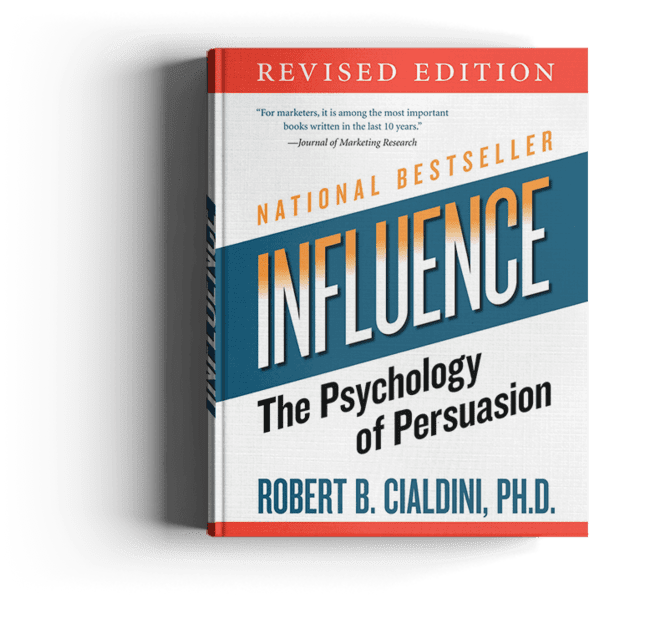
For example, if you saw me buying a tin of peaches at the supermarket, it would increase the likelihood of you buying a tin too.
And if you watch a sitcom with a laugh track you’re much more likely to find it funny. Here’s a video from Friends, minus the laugh track:
Social proof is particularly powerful in situations when you’re uncertain. If you’re unsure of the ‘correct’ behaviour, you’re much more likely to look to others for guidance – just hop in a time-machine and ask your teenage self.
Social Proof As A Weapon…
Social proof can be used as a tool by marketers, entrepreneurs and creators to implant the urge to buy in prospects.
In theory, making loud marketing noises when people buy your stuff should tip the balance in your favour – but this isn’t always the case.
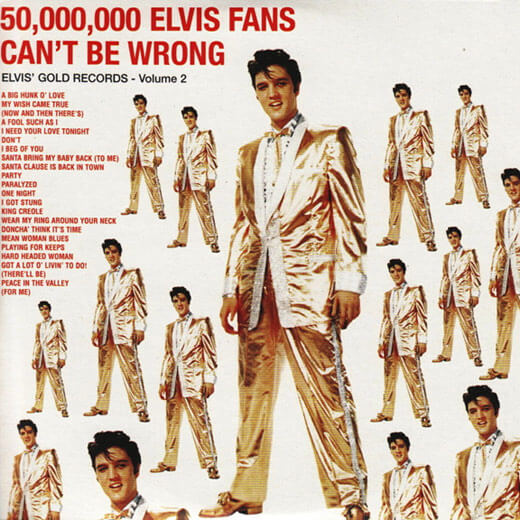
The idea of social proof being a definitively successful marketing tactic is a sweeping generalisation and with all things psychological, doesn’t always prove correct – especially when it’s manufactured.
You’ll soon find out how social proof has increased thievery by 3x, discover how Netflix use social proof to keep you glued to your sofa and uncover how some brands go against the grain by using anti-social proof to increase the demand for their products.
But before any of that, it’s time to put social proof to the test in the real world…
The Social Proof Experiment
My real world social proof experiment needed to achieve two goals:
- Prove that we are influenced by the decisions of those in front of us
- Provide black and white results (without any grey areas) – either social proof can be seen to work, or not.
After a few ideas, I ran with ‘The Leaflet Test.’
For this experiment, I went out onto a busy high-street armed with 200 leaflets. The leaflets featured no offers, promotions or sales copy – just the Einstein Marketer logo and their social media handles.

The idea for the test was simple – people would be much more likely to take a leaflet if they saw somebody else take one. And they’d be much more likely to reject a leaflet if they saw others doing the same.
If social proof rings true as a psychological principle, people would consistently replicate the decision of those in front of them.
But, if acceptances and rejections happened irregularly, social proof would be proven wrong.
Look for the red crosses and green ticks in the bottom left-hand corner of the video – and remember, lots of the same decisions in a row prove that social proof does have some psychological impact.
At the end of an embarrassing hour on the highstreet, the results swayed in favour of social proof.
- The longest streak of acceptances: 7
- The longest streak of rejections: 8
These are the results of a cross-section of 50:

In our experiment, 72% of people copied the decision of those in front of them.
BTW: We’ve got another video experiment coming up a little later in this social proof article.
A Leaflet Transaction Works Like This…
It’s fair to say that I (kinda) enjoyed the leaflet experiment and that may have influenced some of the passersby, but that’s not the only reason why the experiment worked.
A leaflet transaction works like this: I give you a leaflet.

Pretty simple, right?
When we’re offered something like a leaflet, we don’t have to exchange anything more than our attention. This means that there is very little commitment invested in the ‘deal’ from a ‘consumers’ perspective.
Social proof can have a massive effect on a prospect’s decision in situations like this. That’s why many digital marketers create subscription forms with numbers like these…

…SAAS companies create landing pages like these….
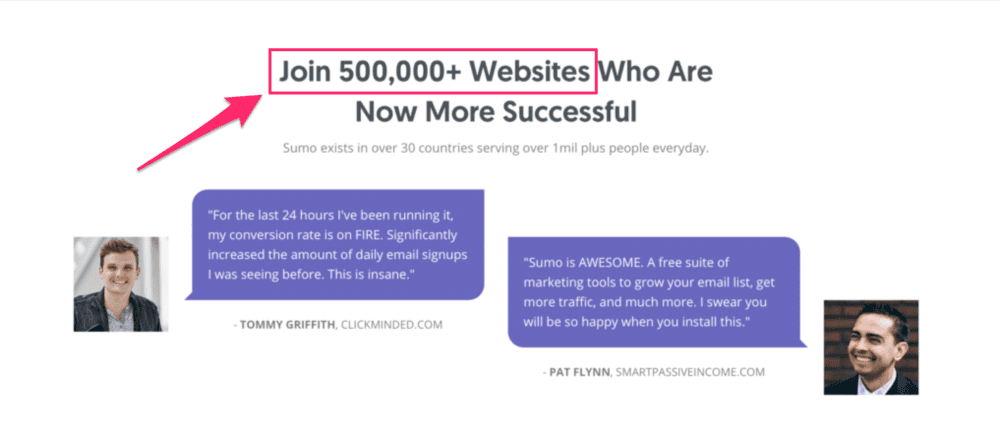
…and eCommerce stores sell products surrounded by messages like these…

…and this is why, when you’re unsure what to watch on Netflix, your first action is to head to the ‘trending’ or ‘Top 10’ category. You’re programmed to trust the decisions of other people (who you don’t know) when a small price is on the line.
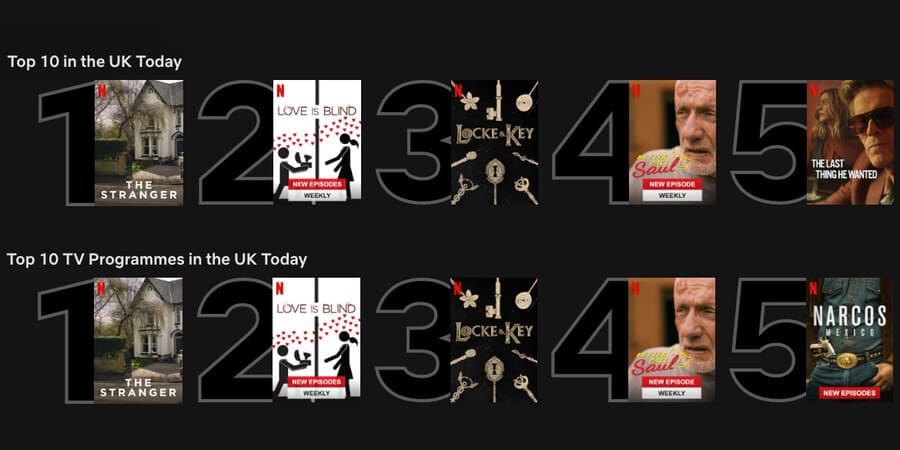
Actionable Conclusion: When making free offers or low-cost products highlight high acceptance numbers (e.g. customer or subscriber counters) to increase conversions. Use language like ‘most-popular’ to encourage prospect’s to take your desired actions.
The Other End Of The Spectrum
But, what would’ve happened if I’d stood on the street selling products at the other end of the spectrum? Would social proof have influenced the decision of my prospects?
Unfortunately, I didn’t try flogging Louis Vuitton bags – although that would’ve made excellent viewing (perhaps I’ll try this in future).
Luxury products are desirable and aspirational, but if these products were in the hands of 25% of the population, would they still have that same draw? Would you consider Rolls Royce to be an aspirational luxury if there were more on the road than there are Fords?

Chanel is an example of the contradiction that surrounds brands who sell products at the top end of the market. In 2017, they were named as the most Influential fashion brand on social, with more than 20 million Instagram followers (today they have 40 million+). And yet, none of their posted content is UGC (user-generated content) and they never share any reviews of their products.

Here is a landing page for a Chanel handbag that costs $5040:
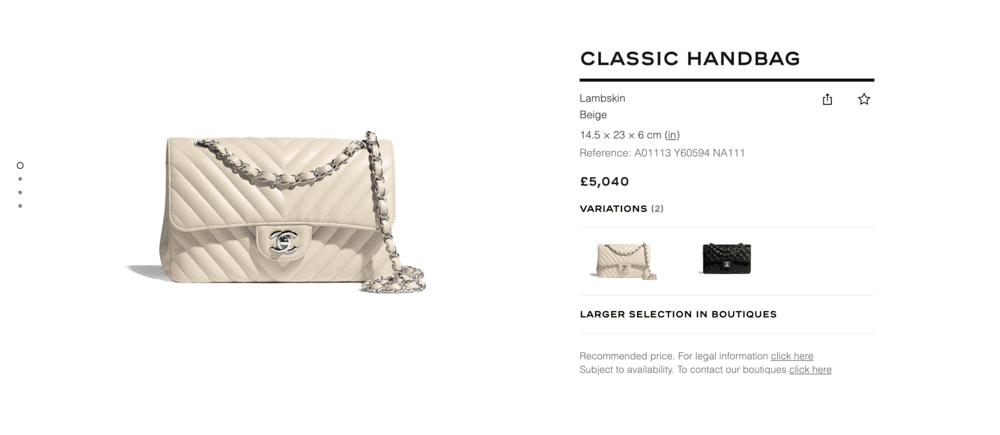
Notice anything about it?
It contains none of the social proof elements that most marketers insist upon. There are no:
- Reviews
- Social share counters
- Testimonials
- Live sales pop-ups
- Social follower numbers

Social proof doesn’t apply to every business in the same way – and as Chanel has proven, tailoring it to suit your brand’s aims is the best way to go.
Their strategy is clear – never show any of their huge audience of followers owning their aspirational items.
In 2019 Chanel posted a 17% increase in operating profit, totalling the measly sum of $3.49 Billion – proving that their digital marketing strategy, including their use of social proof, is working.
Actionable Conclusion: When selling a luxury or high-end product, use social proof to demonstrate high levels of desirability, but don’t show any form of obtainability – unless it’s from an aspirational person (e.g. a celebrity/influencer).
Social Proof: More Than What’s Said
One of the most interesting quotes from the go-to work on social-proof reads like this:
“Since 95 per cent of the people are imitators and only 5 per cent initiators, people are persuaded more by the actions of others than by any proof we can offer.”
Robert Cialdini, Influence: The Psychology of Persuasion

You aren’t as original as you think you are and that’s because, in most situations, you don’t realise that you’re being influenced by external factors.
Social proof is more than what’s said. It isn’t just the words on your landing page, the badges on your check-out or the awards on your about page.
A 2017 article by Scientific American revealed that some of us are serial returners of our shopping trolley (carts if you’re a yank) and some of us regularly dump them in the nearest possible space – but both of these groups are influenced by the behaviour of those in front of us.
If the car park is covered in loose trolleys, the returners will dump theirs, and vice versa.

However, they also noticed that when flyers were left on windshields in a parking lot that was covered in loose trolleys, people were much more likely to throw their flyers to the ground, littering the car park.
The social proof that affects our behaviour doesn’t only come from the direct behaviour of those in front of us – it comes from everything around us.
Another study in London proved that painting children’s faces on the metal shutters of closed shops can reduce crime rates.

As digital marketers, it’s in our interests to not only ensure that ‘direct’ social proof is provided but to create an environmental social proof that’s conducive to our marketing goals.
For example, a bookshop might want to make prospective buyers feel like they’re in the right place to learn by using photos of ‘great minds’ reading the books they sell.
Finance companies tend to use dark blue in their logos because it’s a colour associated with trust (find out more in my guide to colour psychology in marketing).

Many eCommerce companies have changed their CTA button colours from green to orange, purely because Amazon adopts it. After all, if you want to sell more stuff online, it pays to make your store more like the places where people are buying things.

Actionable conclusion: Telling prospects that you’re popular isn’t enough. Use environmental leverage (on your website) to harness another form of social proof.
We Love Our Own Reflections
Think about the last time you saw a group photo that you were a part of – what was the first thing that you looked at?
I’m certain that you were drawn to yourself without hesitation, and I’m certain that this happens every single time you look at a group photo that you’re a part of.

This little-studied phenomenon is known as a magnetiser, and it plays an important role in social proof marketing.
To test this theory, I put together a quick Facebook ads experiment. The test was simple: two Facebook ads, one with a line of social proof, a second without social proof.
Here’s a quick explanation:
The test was not run on a ‘Conversions’ campaign (which would’ve been more suited to the type of Facebook ad I had created). I used a ‘Traffic’ objective to test how many people these ads would catch on the newsfeed and entice to click-through.
The ads were left to run for 3 days, both on a budget of £100.
Here’s what happened:
The results of our social proof marketing experiment on Facebook ads were a lot more weighted than I expected. I suspect that if the test had run for longer and been backed by a bigger budget, the results would’ve been closer.
That being said, it didn’t surprise me to see the 1st ad win.
We love our own reflections, and when we’re presented with text that tallies up with our self-identities, it creates a powerful draw.
If you self-identify as a marketer, entrepreneur or advertiser, the mere sight of the word will attract your attention on a busy social newsfeed. This, combined with social proof makes for powerful marketing.
Actionable conclusion: Analyse your current customers and know who they identify as – use this as often as possible in your marketing materials and align it with social proof. We don’t want to join 10k others, we want to join 10k others who look exactly how we perceive ourselves.
Negative Social Proof
In most cases, social proof informs our behaviour because they’re the actions we’re programmed to take.
For instance, when we’re on holiday, we do touristy things without a second thought for the types of activity that a ‘local’ might enjoy in their leisure time.
In 2014 part of a historical bridge in Paris collapsed after years of tourists padlocking their initials to the frame. It seems absurd that people felt compelled to buy padlocks and lock them to the frame of one specific bridge – but when you understand how social proof works, especially when it’s coupled with self-identity (in this case ‘lovers’) it makes perfect sense.
The authorities at the time warned against more tourists locking their names to the bridge, imploring them to ‘take selfies’ instead, but the pull of social proof was just too strong.
This can be a tool for marketers. When new or relatively inexperienced prospects are drawn into our marketing funnels, many of them will act as instructed because it’s the only action they’re programmed to take.
But this can work the other way too. Showing others doing the ‘wrong thing’ in order to encourage a new group to do the ‘right thing’ can have the opposite effect.
In the case of the Parisian bridge, the authorities would’ve never won as long as the bridge remained covered in padlocks. One American tourist told Reuters, “We came with the idea of putting a lock but we found it’s closed and illegal now. We are just going to put it here at the end of the bridge so no one can see.”
We all think alike, no one thinks very much.
Walter Lippmann
The same thing happened to a group of researchers who were trying to protect an Arizonian forest from visitors stealing wood. In an attempt to quell the crime, they erected a sign with this opening line:
‘Many past visitors have removed the petrified wood from the park, changing the natural state of the petrified forest.’
Thefts tripled in the area around this sign because visitors saw that ‘many past visitors’ had stolen, providing social proof.
This phenomenon is known as negative social proof – it’s given to actions that are considered ‘wrong’ but are made to feel less wrong when we see others doing the same.

Actionable conclusion: Hide any actions that are taken by the many if they’re undesirable to your brand. Do not highlight them to encourage the opposite action.
Sweating The Small Stuff
Social proof means more than simply adding a few impressive numbers to your landing pages or chucking in a few recognisable brand logos.
To truly influence your target market, it means looking at the big picture and drilling your wider aims into a much tighter, granular focus.

Sweating the small social proof details can make a big difference – a study conducted by Cialdini and Goldstein discovered that almost 10% more people agreed to reuse their towel at a hotel when they were presented with this message: ‘Join your fellow guests in helping to the save the environment’, than when they were shown this ‘Help save the environment by reusing your towels.’
A simple change in language in the right place can trigger more desired responses from your target market, as can small additions like social proof pop-ups on your landing pages.

But these small additions shouldn’t be restricted to your paid promotions and buying pages – they need to find their way into your content marketing strategy too.
According to Nielsen, 92% of consumers are more likely to trust non-paid recommendations than any other type of marketing. This means creating content that doesn’t just bring you to par, it means setting a standard that has to be shared amongst peers, friends and colleagues.
Small additions like sharing buttons placed in appropriate places and an increase in ‘shareable content’ can turn a piece of content into a recommendation, which can become a follower, and then a lead, before progressing into a customer.
People want to share things that align themselves with the content that they’re sharing. If you’re insightful, new, creative or ‘advanced’ you’ll achieve shares, provided that you have the appropriate structure in place.
Actionable conclusion: Analyse your headlines and subheadings on your landing pages and make small changes if appropriate (emphasis on ‘small’). Create content that has to be shared and provide your audience with a system that encourages sharing (i.e. give them buttons to press).
A Few Recommendations
In a typical social proof article, you’ll read about 5 ways to increase social proof. So, here’s my top 5:
- Social proof pop-ups (on landing pages)
- High numbers of reviews > testimonials
- Big impressive numbers (where they’ve been earned)
- Shareable content
- Recognisable logos/brand names
Without going into detail, these are 5 tactics that have worked consistently for me. However, if you’ve read the rest of the article, you’ll know that simply replicating these tactics doesn’t mean a replication in improved metrics.
To use social proof successfully in marketing, you need to strike a careful balance that is made-to-measure for your brand.
To help you find your balance, let’s revisit some of the best tips from this social proof study:
TL:DR
- Highlighting high numbers of acceptance rates will increase conversion rates in lower priced (or free) offers – use subscriber or customer counts in your lead or entry priced products
- People will copy the actions of those ahead of them, especially when they feel unsure.
- Luxury products benefit from anti social proof – a product feels more aspirational when it is hard to obtain. Cut back on reviews to make your product seem more luxurious.
- Social proof isn’t only derived from direct actions, it’s drawn from the environment too. Ensure your branding, website design and colouring encourages your target market to take your desired action.
- Use language like ‘most popular’ to influence your market to take the action that you prefer
- Language ‘magnetisers’ draw attention, align them with social proof to increase their power.
- Avoid negative social proof by hiding anything that’s going against your brand.
- Take a granular focus on your marketing messages, consider the wording on your landing page headlines and copy.
- And finally…
Conclusion
Social proof works, but then again, it doesn’t.
Your implementation of social proof in marketing depends on the influence that you’d like to exert on your target market. This article has put that power in your hands.
I’ll be back again next week for Einstein Marketer with another in-depth article. You should join the 25k+ people who subscribed to the blog last year, so you can receive the content directly to your inbox too (in addition to all their other goodies).
Scroll to the bottom of this page and ‘Subscribe!’
- Author Details





23 Responses
Hi Josh.
Great article. I think the part about magnetisers could help my ads. I’ll give it a try.
Brilliant videos as well, make some more. ” don’t worry mate, it’s not religious” lol
Thanks, Alex!
Yes, more videos were the plan before the pandemic – it’s a lot more difficult now though. I’ll try to get some more recorded in the office if we can.
Good luck with the ads, if there’s anything you’re struggling with, let us know and myself or somebody else will cover it in the blog!
I’m OK with the ads, they’re all doing alright. Just love articles about marketing and npsychology. I have been thinking about how I can use it in content to help my business though. Are you making any blogs and videos about that?
Thanks for the fast reply, Alex.
There are a lot of ways of using psychology in content – I published an article about 6 principles that influence consumer behaviour, check it out here: https://www.einsteinmarketer.com/marketing-psychology/
These can be transferred into content too.
The main thing to remember is that you should be publishing content with a ‘business goal’ in mind when you set out – make the psychology fit that aim if you’re going to use it. But above all else, just make sure that you make a great piece of content that your audience is going to love.
OK thank you. I will read it and check your website soon for more blogs.
Thanks, Alex!
Interesting as always Josh. I agree with Alex, make more videos.
Thank you!
Great blog. Thanks Josh.
Thank you!
Great selling with the leaflets.
Do you think that all websites selling stuff online needs to look like amazon though?
Hey Bill,
Thanks for the comment!
The answer to your question isn’t a simple one. Every website should have its own branding that fits with the business and the demographics of their target market, as well as being conducive to environmental social proof, but there are certainly elements of e-commerce websites like Amazon that online retailers should consider implementing. Like anything, these things are worth testing and it is dependent on which end of the market you’re targeting, but reviews, testimonials, social proof pop-ups, stock quantities (when they’re low) are a good place to start.
I hope this helps.
Very funny videos and informative guide about social proof. Thank you.
Thanks Arthur.
That is the proper blog for anybody who needs to search out out about this topic.
This is my third visit to this blog. I am thinking about starting a brand new blog in the same category. Your site gave me some ideas to work with. (Dont worry, I wont be copying you ) You have done a nice job.
Sounds good. This is a useful and informative article. Thanks a lot for sharing this information with us.
Is it okay to post some of this on my site if I include a backlink to this page?
I genuinely appreciate your work, Great post.
Josh, please tell me that you’re going to publish more marketing psychology stuff like this?
Hello, could I reference some of the content from this post if I provide a link back to your site?
Hi Xiao, of course.
I read a few of your posts and thought they are well written. Thank you Josh